Sharks are commonly associated with fear, mainly because of movies like The Meg, The Shallow, and the classic, Jaws. However, saltwater Black Tip Sharks are popular as animal companions.
Personally, I do not agree with this practice, since these beautiful creatures are meant to live in the open waters.
The good news is that freshwater Sharks exist, and they are as interesting as their saltwater counterparts.
Here are some freshwater Sharks you can look into.
BLACK SHARK

The Black Shark (Labeo chrysophekadion) is also known as the Black Labeo. This Fish actually comes from the Carp family, which means they’re only a Shark by name.
They are characterized by their huge dorsal erect dorsal fin. They have firm bully-like heads and large scales. Their bodies are colored black with a gold tint.
SIZE
This fish can grow up to 10 inches long when in captivity.
ORIGIN
They originated from Southeast Asia. Particularly, they came from Laos in the Mekong basin, Cambodia, Vietnam in the Dong Nai drainage, and Thailand in the Mae Klong and Chao Phraya water systems.
TEMPERAMENT
They are highly aggressive Fishes. They should therefore be grouped with Fishes who can handle their aggressive nature. An example of this are New World Cichlids.
EASE OF CARE
Intermediate. They tend to dig up plants, so the plants need to be rooted well in the tank.
Overall, this Shark-like Carp may be quite challenging for beginners.
BALA SHARK
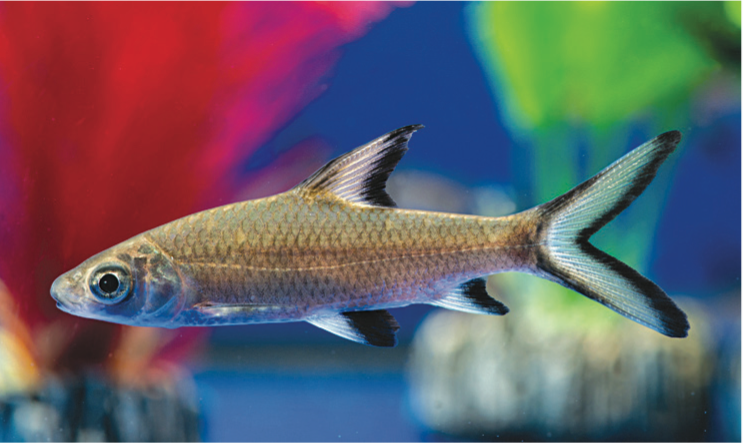
The Bala Shark (Balantiocheilus melanopterus) is popular for their Shark-like shape and fantastic fin patterns. This Fish has large eyes and a silver body, with black margins on their fins.
SIZE
The Bala Shark can grow up to 12 inches long. Female Sharks are usually shorter than males.
ORIGIN
They came from the rivers of Kalimantan, Malaysia, Thailand, Cambodia, and Sumatra.
TEMPERAMENT
This Shark has a milder temperament compared to freshwater Sharks. However, it is best not to keep small Fishes as tankmates, as their diet consists of small Fishes.
It is also best if they are kept in groups of three as they are known to be schooling Fishes. Aside from this, other aspects to note are their sensitivity to water changes.
EASE OF CARE
This is another Shark-like Fish that would make a great animal companion for beginners. I keep Bala Sharks with my Koi Fishes and they fit well.
COLUMBIAN SHARK

Like the first two Sharks, the Columbian Shark (Ariopsis seemanni) is a Carp and is also known as the Tete Sea Catfish.
Their body is gray or light brown with spots and bands. This Shark has a bulky build and a blunt head. Because of this, they are sometimes dubbed “Bull Sharks.”
SIZE
They have an average size of about 12 to 14 inches.
ORIGIN
This Shark can be found in the waters of Mexico, Panama, Nicaragua, Ecuador, Guatemala, Costa Rica, El Salvador, Colombia, and Peru.
TEMPERAMENT
Their active and lively nature is one of the main reasons why they’re popular among those caring for Fishes. Compared to the other Sharks, they are active during the day.
However, they feed on smaller Fishes. That means it’s best to keep them with larger Fishes instead.
EASE OF CARE
Intermediate. Generally, if you want a more energetic “Shark” in your tank, then this fella is for you.
RED TAIL SHARK
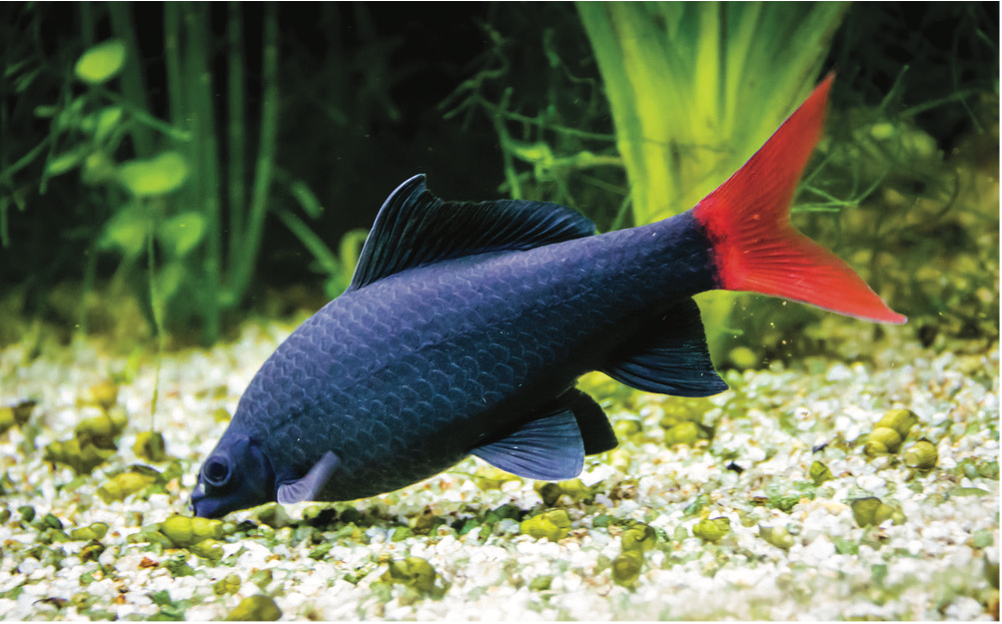
The Red Tail Shark (Epalzeorhynchos bicolor) is also known as the Fire Tail Shark, the Red Tail Shark Minnow, and the Tailed Black Shark.
Their feisty personality matches their looks. With their beautifully dark body paired with their red tail, this Fish is like a lit matchstick.
SIZE
The Red Tail Shark grows up to 6 inches long.
ORIGIN
They originate from Thailand.
TEMPERAMENT
This Shark is more aggressive than others. Because of their fiery personality, keeping them together is not ideal. Instead, it is best to keep them with Fishes who lay low in the water because these Sharks swim closer to the surface.
Also, their tank mates should not be as temperamental as they are.
EASE OF CARE
Intermediate. If ever one wishes to have a Flaming Fish in their tank who bursts with color and activity, then consider caring for them.
RAINBOW SHARK
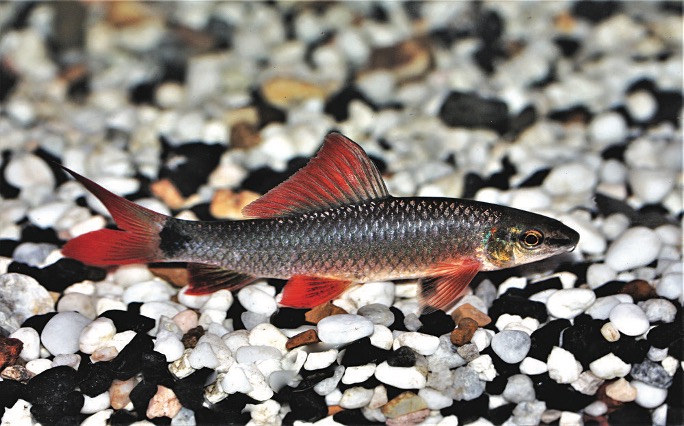
The Rainbow Shark (Epalzeorhynchos frenatum) is also referred to as the Ruby or Red-Finned Shark.
This species is classified as a Catfish. Contrary to their name, they do not have rainbow colors; instead, they have a dark blue, light blue, or black body, with bright orange to red fins. They have a pointed snout and flat belly. The males have a more slender body compared to females.
SIZE
Their size is about 6 inches long.
ORIGIN
This Fish originates from Southeast Asia, specifically Myanmar, Thailand, Malaysia, and Laos.
TEMPERAMENT
They also have a semi-aggressive temperament and tend to intimidate fellow tank mates. Particularly, they tend to intimidate other same-sized Rainbow Sharks or Fishes who look like Rainbow Sharks.
It is advisable to have tank mates who do not look like them and are not as aggressive. Another thing to note is that it is difficult to have this Fish reproduce; a larger tank is required if you plan on breeding them.
EASE OF CARE
Intermediate.
IRIDESCENT SHARK
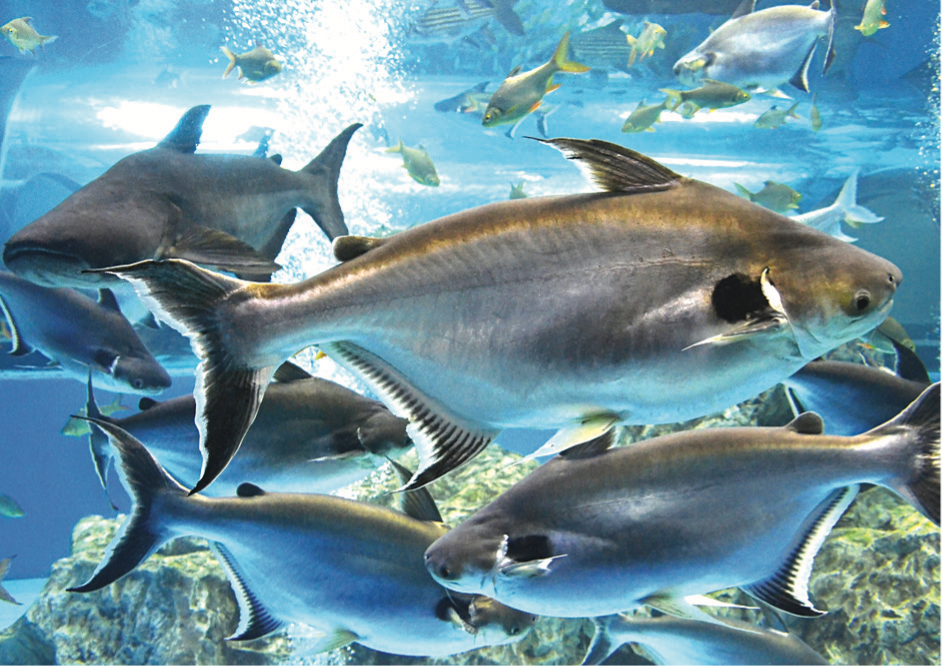
The Iridescent Shark (Pangasianodon hypophthalmus) is also a Catfish rather than an actual Shark. They are also known
as the Sutchi Catfish, Siamese Shark, Marbled Catshark, or the Iridescent Catfish.
They have dark brown marble- like patterns on their bodies.
SIZE
An adult Shark is about 1.2 to 2.4 meters, making them one of the bigger Sharks in this article..
ORIGIN
Southeast Asia.
TEMPERAMENT
This Fish is docile, except when they are being fed. Do not keep other Fishes whom they might eat; Cichlids and Silver Dollars serve as good options as tank mates.
EASE OF CARE
It is important to keep the tank clean to avoid skin diseases like ich, as the Iridescent Fish is susceptible to it.
SILVER APOLLO SHARK
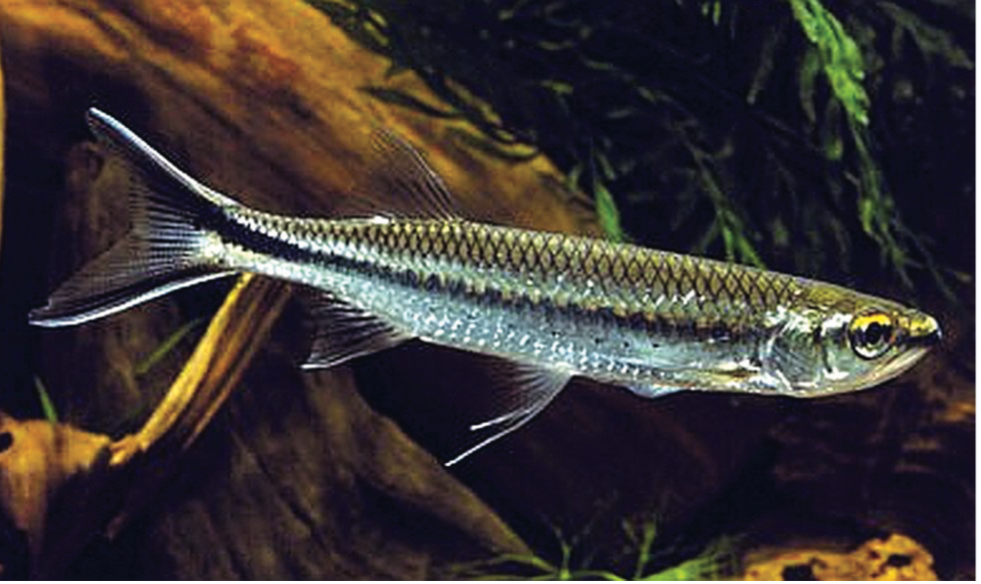
The Silver Apollo Shark (Luciosoma setigerum) has a couple of lookalikes, such as the Long-finned Apollo Shark and Luciosoma Pellegrini, a fish from Borneo. They are schooling Fishes shaped like torpedos.
SIZE
Their length is about 10 inches.
ORIGIN
They are usually found in Borneo, Thailand, Sumatra, and the Peninsula of Malay.
TEMPERAMENT
Apollo sharks are peaceful. They are sociable rather than territorial. Their tank mates must match their high spirits and keep up with their active nature.
EASE OF CARE
It is best to keep 6 to 12 of them at a time and to keep them with tank mates whom they would not be able to eat. If you want to liven up your aquarium and not worry too much about your Fishes harassing one another, then you might enjoy caring for this species.
CHINA HIGH-FIN BANDED SHARK

The Chinese High-Fin Banded Shark (Myxocyprinus asiaticus) has a dark-colored body with slanted banks and has extremely huge dorsal fins.
SIZE
They can grow up to 4.5 feet.
ORIGIN
They are native to the Yangtze River in China..
TEMPERAMENT
Compared to the other Sharks or Fishes mentioned in the list, this Shark is certainly the most passive to the point of being lazy, which is what they’re known for. They usually spend most of the day napping soundly at the bottom of the tank.
Nevertheless, smaller Fishes can still become their next meal, which means that these smaller individuals are not their ideal tankmates
EASE OF CARE
Easy to care for due to their calm temperament.
Overall, they are quiet and peaceful large Fishes who, when one looks at their calm state, can make one feel at peace, too.
PAROON SHARK

The Paroon Shark (Pangasius sanitwongsei) is also a type of Catfish rather than an actual Shark, and one of the larger Catfishes in this list. This Fish is also considered to be a critically endangered species, which explains why they are mostly distributed by aquatic farms.
SIZE
This shark can grow up to 10 feet long.
ORIGIN
They can be found in these countries: Cambodia, Thailand, Indonesia, and Vietnam.
TEMPERAMENT
They are very active and tend to be skittish and do not like confined spaces. They have the tendency to bump their heads against the tank when stressed or restricted.
EASE OF CARE
Advanced.

FRESH IDEAS
Commonly available in our local fish stores are the Black Shark, Bala Shark, Red Tail Shark, Rainbow Shark, Hammerhead Shark, China High Fin, and Paroon Sharks. Popular tankmates for most freshwater Sharks are Stingrays, Flagtail, Hooks, Silver dollar, Pacu, and the Arowana.
Someday, I would like to create a single species gallery and a community setup for freshwater Sharks. My biggest challenge would be the size range of each species. For now, I am happy just envisioning my setups for them.
For questions, please email [email protected].
“Blessed are the merciful, for they shall receive mercy.” – Matthew 5:7 ESV






